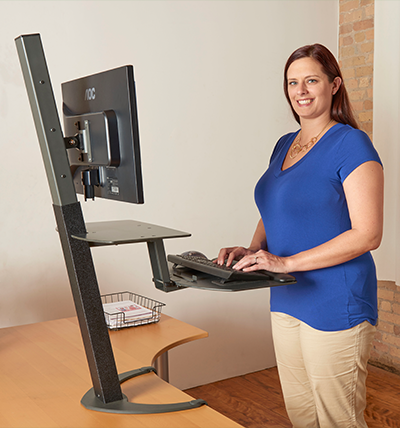Office real estate is not cheap. It can cost several hundred dollars a month to pay for a single office. C-Suite offices cost even more. Add in the costs of office furniture, including modern designed sit stand ergonomics like Health Postures‘ Taskmate and ergonomic desk lift, and it’s understandable why more small to midsize businesses, even large corporations, are moving from traditional office setups to high function spaces. To save money on sit to stand ergonomics, organizations need to opt for ergonomic products that last a long time.
What about sit stand ergonomics in high functioning work spaces
High functioning work space designs are diverse. In one setting, you might see two long tables pushed together, monitors resting atop the tables one next to the other. Another example of a high functioning work space is of a reception area type of space that has a sofa at the back of a table.
Laboratory type desks that are situated four tables by four tables is a third type of high functioning work space. These work space designs are not compatible with large, heavy, hard to adjust standing desks. Space is limited. Products like the Health Postures’ TaskMate and the ergonomic desk lift are built to take up minimal space.
Longevity for the Health Postures’ TaskMate and the ergonomic desk lift is made possible because of materials like durable wood and metal lifts, clamps and levers.
Making sit stand ergonomics work in an ever changing world
Other factors that play into the life span of ergonomics that offer healthy sit to stand desk benefits include the products’ adjustability. For example, if sit to stand desk benefits are to be truly realized in a changing work environment, ergonomics like the Health Postures TaskMate need to be easy for several people to use.
In a high functioning work environment, five different people might work at the same desk. This is because employees choose their own desk based on when they arrive to the office, early arrivals getting a broader selection for their for-the-day desk location.
Short workers might push down on the desk to lower monitor height. Tall workers might try to force desk to higher levels to avoid neck and back pain. Ergonomics like Health Postures’ TaskMate Go and ergonomic desk lift are built with levers that raise and lower table height in a matter of seconds.
It wouldn’t be surprising if organizations started to require ergonomics manufacturers to design desks that best suit their modern work environments. These desks would be created with durable materials. They would also be easy to adjust. Yet, even with these sit to stand desk benefits, the major benefit of using standing solutions concerns individual worker health.
Standing desks help to reduce obesity and encourage mobility. It’s even possible to lose 5 to 20 pounds in a year if you are active and stand enough while working at a sit to stand desk. You may also feel more engaged at work. Muscle pain and headaches could be reduced as well.







